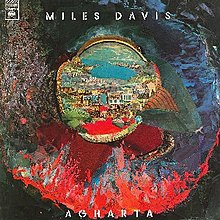Agharta (album)
| Agharta | ||||
|---|---|---|---|---|
 |
||||
| Live album by Miles Davis | ||||
| Released | August 1975 | |||
| Recorded | February 1, 1975 | |||
| Venue | Festival Hall in Osaka | |||
| Genre | Jazz-rock, funk rock, avant-garde, ambient | |||
| Length | 97:34 | |||
| Label | CBS/Sony | |||
| Producer | Teo Macero | |||
| Miles Davis chronology | ||||
|
||||
| Alternate cover | ||||

1976 North American edition
|
||||
| Retrospective reviews | |
|---|---|
| Review scores | |
| Source | Rating |
| All Music Guide to Jazz | |
| Christgau's Record Guide | A |
| Down Beat | |
| Encyclopedia of Popular Music | |
| Music Story | |
| MusicHound Jazz | 5/5 |
| The Penguin Guide to Jazz | |
| The Rolling Stone Album Guide | |
| Rolling Stone Jazz Record Guide | |
| Sputnikmusic | 4.5/5 |
Agharta is a 1975 live double album by American jazz trumpeter, composer, and bandleader Miles Davis. By the time he recorded the album, Davis was 48 years old and had alienated many in the jazz community while attracting younger rock audiences with his radical electric fusion music. After experimenting with different line-ups, he established a stable live band in 1973 and toured constantly for the next two years, despite physical pain from worsening health and emotional instability brought on by substance abuse. During a three-week tour of Japan in 1975, Davis performed two concerts at the Festival Hall in Osaka on February 1; the afternoon show produced Agharta and the evening show was released as Pangaea the following year.
Davis led a septet at the concert; saxophonist Sonny Fortune, bassist Michael Henderson, and guitarist Pete Cosey were given space to improvise against a dense backdrop of riffs, electronic effects, cross-beats, and funk grooves from the rhythm section—drummer Al Foster, guitarist Reggie Lucas, and percussionist James Mtume. Davis controlled their rhythmic and musical direction with hand and head gestures, phrases played on his wah-wah processed trumpet, and drones from an accompanying electronic organ. The evolving nature of the performance led to the widespread misunderstanding that it had no compositional basis, while its dark, angry, and somber musical qualities were seen as a reflection of the musician's emotional and spiritual state at the time.
...
Wikipedia
